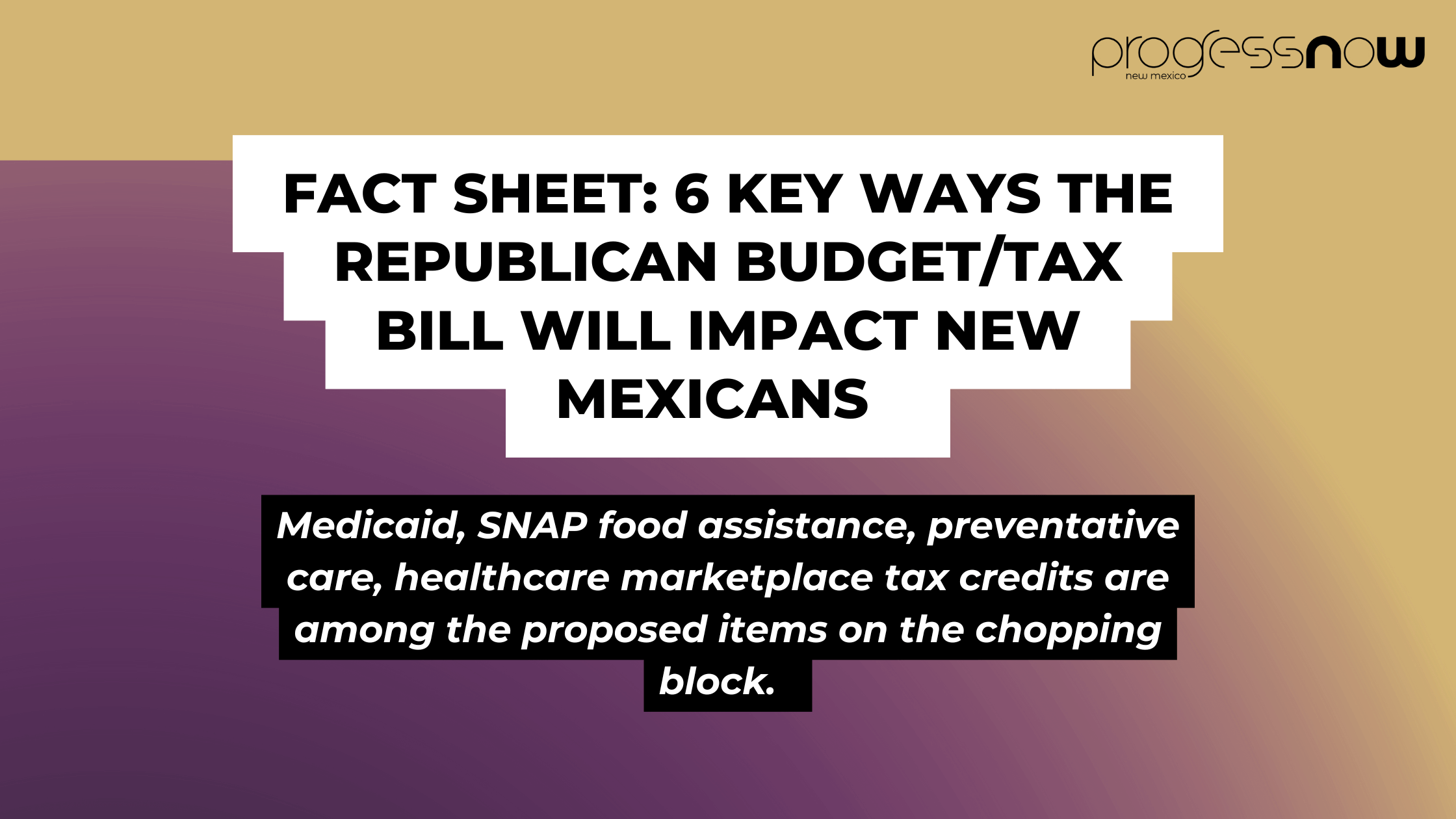We took a look at the massive budget bill passed by House Republicans which adds $3.8T to the federal deficit and provides tax cuts to the wealthy at the expense of hardworking families.
It would hit particularly hard for rural New Mexicans who participate in Medicaid and SNAP, based on a review of recent data.
The bill, which copies provisions from the Project 2025 playbook created by the Heritage Foundation and top Trump advisors, is slated for discussion in the US Senate in June.
All three of New Mexico’s congressional representatives – Teresa Leger Fernandez, Melanie Stansbury, and Gabe Vasquez – voted against the bill when it passed the US House. US Senators Ben Ray Luján and Martin Heinrich have also expressed serious concern about the bill.
Here are some of the key impacts to New Mexican families…
1) Gut Medicaid
Drastic cuts to Medicaid are a central focus of the bill passed by House Republicans.
The bill they passed would lead to an estimated 125,000 New Mexicans losing healthcare coverage and at least 395 avoidable deaths per year, according to research by the Center for American Progress.
It would also deliver a major blow to kids and older adults in rural areas that have struggled amidst an ongoing shortage of providers and clinics.
Notably, over half of pregnant New Mexicans rely on Medicaid for coverage, and more than 60% of children in the state are also covered by Medicaid, making this bill’s cuts especially harmful to vulnerable populations as hospitals and clinics are forced to reduce care or shut down.
2) Cut reproductive health care
The bill also cuts reproductive healthcare, targeting Planned Parenthood specifically by eliminating funding for basic care including pap smears, breast cancer screenings, STI tests, and birth control medication.
This would have a serious economic impact by putting nurses and critical care staff out of work. It would also force New Mexicans to drive even farther to treat an emergency or see a doctor.
3) Eliminate SNAP food assistance
In its current form, the bill would take away an estimated $260B from SNAP food assistance benefits, a life-saving program formerly known as “food stamps.”
It’s hard to overstate the economic impact of these cuts. Each dollar of SNAP benefits spent equates to $1.79 in economic activity. Many smaller shops and stores, especially in rural communities across New Mexico, rely heavily on SNAP being spent in their stores.
Cutting SNAP would also weaken innovative programs like the Double Up Food Bucks initiative, which makes it easy for participants to buy fresh fruits and veggies grown here in New Mexico, while also reinforcing local farmers and ranchers.
There are currently 451,200 New Mexicans who use SNAP to purchase groceries, fresh food, and local produce.
4) Skyrocket health care costs in the Affordable Care Act marketplace
Around 22 million people across the US, including 3 million small business owners, would see their health coverage costs skyrocket or would lose coverage altogether next year because the bill fails to extend the premium tax credit (PTC) enhancements, which are critical to making health coverage in the Affordable Care Act marketplace more affordable.
55,481 New Mexico residents took part in a marketplace plan in 2024, and enrollment in the state has increased by 49% since 2020, according to KFF. About 84% of participants received an advanced premium tax credit to assist with their premium costs.
5) Cut higher education aid such as student loans and Pell Grants
The bill would limit key tools for working parents and first generation college graduates in New Mexico who seek to build a better life and contribute to their communities.
It replaces repayment plans based on income with a one-size-fits-all program that increases costs for all current borrowers. For example, 40,300 New Mexicans enrolled in the SAVE program would pay $2,700 to $4,100 more each year, according to analysis from the Center for American Progress.
Additionally, the Pell Grant program, which provides aid to low- and moderate-income households, would limit access for people who attend school part-time. For example, undergrads would need to be enrolled at least half-time to qualify for any aid and would have to take a full course load to receive a maximum grant.
In New Mexico, 44,156 people are Pell Grant Recipients, with an average award of $4,667 in 2024, according to the Education Data Initiative.
6) Give massive tax cuts to the wealthy at the expense of hardworking families
Under the bill, the average New Mexican family earning less than $50,000 would get under $300 in tax cuts in 2027, less than $1 a day. The average tax payer earning $1 million or more a year would receive about $90,000 in tax breaks, according to analysis from the Center on Budget and Policy Priorities.
It would also drastically reduce estate taxes for multimillionaires and billionaires. For example, it would raise the estate tax exemption to $15 million for single people and $30 million for couples, so that a couple could leave $29.99 million to their heirs in 2026 without paying a single cent of estate tax.

